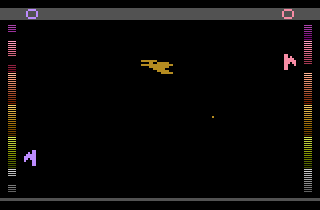
Classic



Poorlords



Computer,
Classic



Computer,
Poorlords



Classic



Poorlords



 |
Vs. Computer, Classic |
 |
||
 |
 |
Vs. Computer, Poorlords |
 |
 |
 |
Vs. Easy Computer, Classic |
 |
||
 |
 |
Vs. Easy Computer, Poorlords |
 |
 |
 |
Two Player, Classic |
 |
||
 |
 |
Two Player, Poorlords |
 |
 |
| Setting | Ball Speed |
|---|---|
| A/Expert | Fast |
| B/Novice | Slow |
 Kirk Israel is a software developer currently living in the suburbs of Boston.
He is fluent in Java, Perl, and several other computer languages. JoustPong is
Kirk's first foray into Atari programming.
Kirk Israel is a software developer currently living in the suburbs of Boston.
He is fluent in Java, Perl, and several other computer languages. JoustPong is
Kirk's first foray into Atari programming. 


